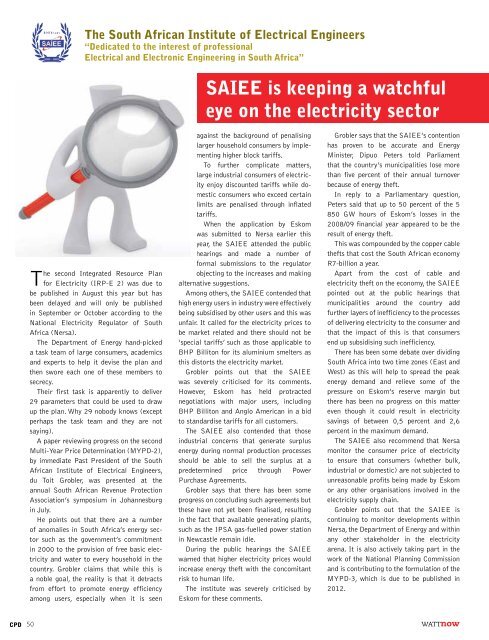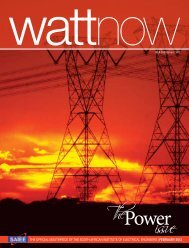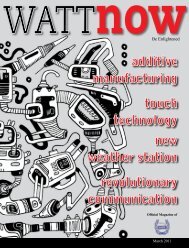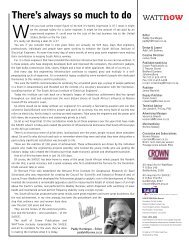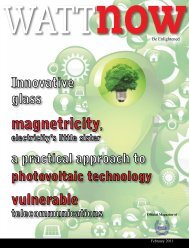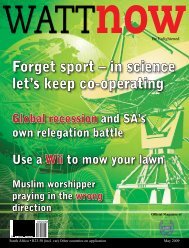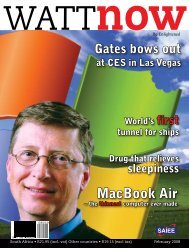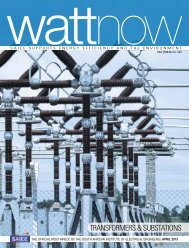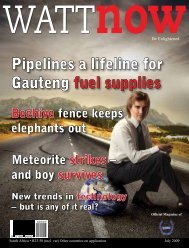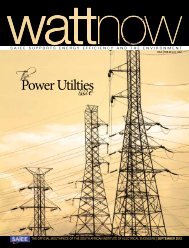download a PDF of the full September 2010 issue - Watt Now ...
download a PDF of the full September 2010 issue - Watt Now ...
download a PDF of the full September 2010 issue - Watt Now ...
- No tags were found...
You also want an ePaper? Increase the reach of your titles
YUMPU automatically turns print PDFs into web optimized ePapers that Google loves.
The South African Institute <strong>of</strong> Electrical Engineers“Dedicated to <strong>the</strong> interest <strong>of</strong> pr<strong>of</strong>essionalElectrical and Electronic Engineering in South Africa”SAIEE is keeping a watchfuleye on <strong>the</strong> electricity sectorThe second Integrated Resource Planfor Electricity (IRP-E 2) was due tobe published in August this year but hasbeen delayed and will only be publishedin <strong>September</strong> or October according to <strong>the</strong>National Electricity Regulator <strong>of</strong> SouthAfrica (Nersa).The Department <strong>of</strong> Energy hand-pickeda task team <strong>of</strong> large consumers, academicsand experts to help it devise <strong>the</strong> plan and<strong>the</strong>n swore each one <strong>of</strong> <strong>the</strong>se members tosecrecy.Their first task is apparently to deliver29 parameters that could be used to drawup <strong>the</strong> plan. Why 29 nobody knows (exceptperhaps <strong>the</strong> task team and <strong>the</strong>y are notsaying).A paper reviewing progress on <strong>the</strong> secondMulti-Year Price Determination (MYPD-2),by immediate Past President <strong>of</strong> <strong>the</strong> SouthAfrican Institute <strong>of</strong> Electrical Engineers,du Toit Grobler, was presented at <strong>the</strong>annual South African Revenue ProtectionAssociation’s symposium in Johannesburgin July.He points out that <strong>the</strong>re are a number<strong>of</strong> anomalies in South Africa’s energy sectorsuch as <strong>the</strong> government’s commitmentin 2000 to <strong>the</strong> provision <strong>of</strong> free basic electricityand water to every household in <strong>the</strong>country. Grobler claims that while this isa noble goal, <strong>the</strong> reality is that it detractsfrom effort to promote energy efficiencyamong users, especially when it is seenagainst <strong>the</strong> background <strong>of</strong> penalisinglarger household consumers by implementinghigher block tariffs.To fur<strong>the</strong>r complicate matters,large industrial consumers <strong>of</strong> electricityenjoy discounted tariffs while domesticconsumers who exceed certainlimits are penalised through inflatedtariffs.When <strong>the</strong> application by Eskomwas submitted to Nersa earlier thisyear, <strong>the</strong> SAIEE attended <strong>the</strong> publichearings and made a number <strong>of</strong>formal submissions to <strong>the</strong> regulatorobjecting to <strong>the</strong> increases and makingalternative suggestions.Among o<strong>the</strong>rs, <strong>the</strong> SAIEE contended thathigh energy users in industry were effectivelybeing subsidised by o<strong>the</strong>r users and this wasunfair. It called for <strong>the</strong> electricity prices tobe market related and <strong>the</strong>re should not be‘special tariffs’ such as those applicable toBHP Billiton for its aluminium smelters asthis distorts <strong>the</strong> electricity market.Grobler points out that <strong>the</strong> SAIEEwas severely criticised for its comments.However, Eskom has held protractednegotiations with major users, includingBHP Billiton and Anglo American in a bidto standardise tariffs for all customers.The SAIEE also contended that thoseindustrial concerns that generate surplusenergy during normal production processesshould be able to sell <strong>the</strong> surplus at apredetermined price through PowerPurchase Agreements.Grobler says that <strong>the</strong>re has been someprogress on concluding such agreements but<strong>the</strong>se have not yet been finalised, resultingin <strong>the</strong> fact that available generating plants,such as <strong>the</strong> IPSA gas-fuelled power stationin Newcastle remain idle.During <strong>the</strong> public hearings <strong>the</strong> SAIEEwarned that higher electricity prices wouldincrease energy <strong>the</strong>ft with <strong>the</strong> concomitantrisk to human life.The institute was severely criticised byEskom for <strong>the</strong>se comments.Grobler says that <strong>the</strong> SAIEE’s contentionhas proven to be accurate and EnergyMinister, Dipuo Peters told Parliamentthat <strong>the</strong> country’s municipalities lose morethan five percent <strong>of</strong> <strong>the</strong>ir annual turnoverbecause <strong>of</strong> energy <strong>the</strong>ft.In reply to a Parliamentary question,Peters said that up to 50 percent <strong>of</strong> <strong>the</strong> 5850 GW hours <strong>of</strong> Eskom’s losses in <strong>the</strong>2008/09 financial year appeared to be <strong>the</strong>result <strong>of</strong> energy <strong>the</strong>ft.This was compounded by <strong>the</strong> copper cable<strong>the</strong>fts that cost <strong>the</strong> South African economyR7-billion a year.Apart from <strong>the</strong> cost <strong>of</strong> cable andelectricity <strong>the</strong>ft on <strong>the</strong> economy, <strong>the</strong> SAIEEpointed out at <strong>the</strong> public hearings thatmunicipalities around <strong>the</strong> country addfur<strong>the</strong>r layers <strong>of</strong> inefficiency to <strong>the</strong> processes<strong>of</strong> delivering electricity to <strong>the</strong> consumer andthat <strong>the</strong> impact <strong>of</strong> this is that consumersend up subsidising such inefficiency.There has been some debate over dividingSouth Africa into two time zones (East andWest) as this will help to spread <strong>the</strong> peakenergy demand and relieve some <strong>of</strong> <strong>the</strong>pressure on Eskom’s reserve margin but<strong>the</strong>re has been no progress on this mattereven though it could result in electricitysavings <strong>of</strong> between 0,5 percent and 2,6percent in <strong>the</strong> maximum demand.The SAIEE also recommend that Nersamonitor <strong>the</strong> consumer price <strong>of</strong> electricityto ensure that consumers (whe<strong>the</strong>r bulk,industrial or domestic) are not subjected tounreasonable pr<strong>of</strong>its being made by Eskomor any o<strong>the</strong>r organisations involved in <strong>the</strong>electricity supply chain.Grobler points out that <strong>the</strong> SAIEE iscontinuing to monitor developments withinNersa, <strong>the</strong> Department <strong>of</strong> Energy and withinany o<strong>the</strong>r stakeholder in <strong>the</strong> electricityarena. It is also actively taking part in <strong>the</strong>work <strong>of</strong> <strong>the</strong> National Planning Commissionand is contributing to <strong>the</strong> formulation <strong>of</strong> <strong>the</strong>MYPD-3, which is due to be published in2012.50


